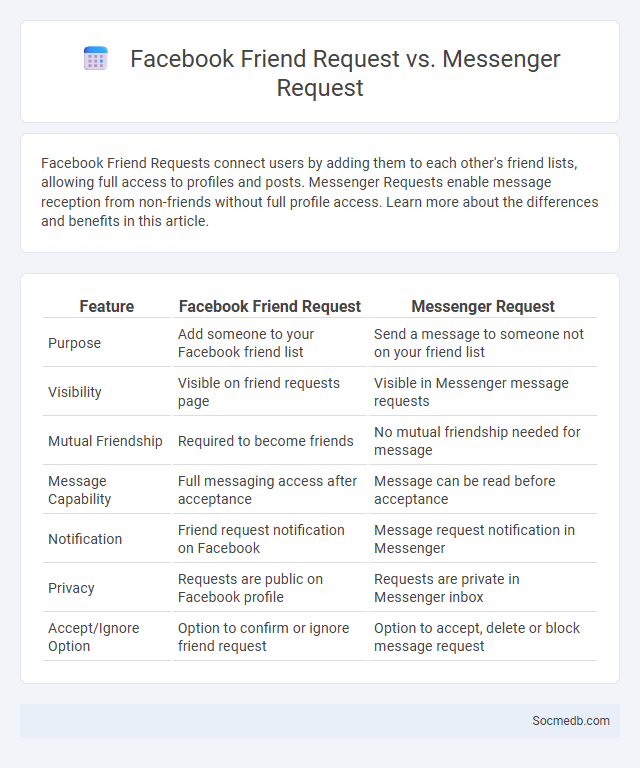
Photo illustration: Facebook Friend Request vs Messenger Request
Facebook Friend Requests connect users by adding them to each other's friend lists, allowing full access to profiles and posts. Messenger Requests enable message reception from non-friends without full profile access. Learn more about the differences and benefits in this article.
Table of Comparison
| Feature | Facebook Friend Request | Messenger Request |
|---|---|---|
| Purpose | Add someone to your Facebook friend list | Send a message to someone not on your friend list |
| Visibility | Visible on friend requests page | Visible in Messenger message requests |
| Mutual Friendship | Required to become friends | No mutual friendship needed for message |
| Message Capability | Full messaging access after acceptance | Message can be read before acceptance |
| Notification | Friend request notification on Facebook | Message request notification in Messenger |
| Privacy | Requests are public on Facebook profile | Requests are private in Messenger inbox |
| Accept/Ignore Option | Option to confirm or ignore friend request | Option to accept, delete or block message request |
Understanding Facebook Friend Requests
Facebook friend requests allow users to connect and expand their social network by sending an invitation to another user for mutual friendship. Accepting a friend request grants access to personal posts, photos, and shared activity, enhancing social interaction and engagement on the platform. Managing friend requests effectively helps maintain privacy, control over the online social circle, and reduces exposure to unwanted contacts.
What is a Messenger Request on Facebook?
A Messenger Request on Facebook is a message from someone who is not in Your friends list, filtered into the Message Requests folder to protect Your inbox from unwanted contacts. This feature allows you to review messages from unknown senders without notifying them whether you've seen them, ensuring privacy and control over communications. Managing these requests helps maintain Your social media experience secure and organized by preventing spam and unwanted conversations.
Key Differences: Friend Requests vs Messenger Requests
Friend Requests on social media establish mutual connections, allowing both users to share posts and view each other's profiles, while Messenger Requests enable one user to send private messages without confirming a friendship. Friend Requests typically require acceptance to activate full social interaction, whereas Messenger Requests can be ignored or filtered without notifying the sender. Understanding these differences helps users manage their privacy and communication preferences effectively across platforms like Facebook and Instagram.
How Does the Facebook Friend Request System Work?
Facebook's friend request system allows you to connect with others by sending a request that the recipient can accept or ignore, establishing mutual friendship on the platform. When you send a friend request, the system notifies the recipient, who can then decide to confirm, delete, or block your request. Accepted requests enable both parties to share posts, photos, and updates, expanding your social network within Facebook's ecosystem.
Accepting vs Ignoring Requests: What Happens Next?
Accepting social media requests often expands your network, increasing visibility and engagement opportunities while exposing you to diverse content and potential collaborations. Ignoring requests may limit your online growth and isolate you from new audiences but can protect privacy and reduce unwanted interactions. The choice directly impacts personal branding, algorithmic suggestions, and the overall digital footprint on platforms like Facebook, Instagram, and LinkedIn.
Privacy Implications: Friend Requests vs Messenger Requests
Friend requests on social media often expose users to a broader network, increasing the risk of unauthorized access to personal information. Messenger requests allow for more controlled interactions but can still lead to privacy breaches through direct messaging features if not properly managed. Users must adjust privacy settings to limit unknown contacts and monitor incoming connections to safeguard their digital presence effectively.
Common Reasons for Receiving Messenger Requests
Messenger requests often come from individuals not in your contact list, aiming to initiate new conversations or network connections. These requests may also arise from people trying to verify information, promote products, or join group chats. Privacy settings and user profiles influence how frequently users receive such unsolicited messages.
Managing and Controlling Facebook Requests
Effectively managing and controlling Facebook requests involves using privacy settings to filter message requests and friend invitations, enabling users to prioritize connections and avoid unwanted interactions. Utilizing Facebook's tools such as the message request folder and custom friend lists helps streamline communication and maintain a secure online environment. Regularly reviewing and adjusting these controls enhances user experience by preventing spam and protecting personal information.
Risks and Safety Tips for Handling Requests
Social media platforms often expose users to risks such as phishing attempts, fake profiles, and privacy breaches that can compromise Your personal information. To protect Yourself, verify friend requests by reviewing mutual connections and avoid sharing sensitive details with unknown contacts. Regularly update privacy settings and use two-factor authentication to enhance Your account security against unauthorized access.
Best Practices for Managing Facebook Connections
Effective management of Facebook connections involves regularly reviewing your friend list to remove inactive or irrelevant contacts, ensuring your network remains meaningful and engaging. You should customize privacy settings to control who can see your posts and personal information, safeguarding your digital presence. Engaging authentically with your connections by liking, commenting, and sharing relevant content helps maintain strong relationships and boosts your social visibility.
 socmedb.com
socmedb.com